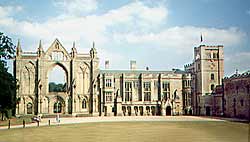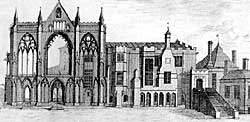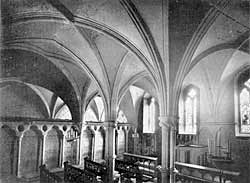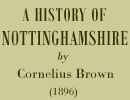< Previous | Contents | Next >
Newstead Abbey

The west front of Newstead Abbey. The surviving remains of the priory church on the right have been described by Pevsner as "an execeptionally perfect example of a late 13th century church front". (A. Nicholson, 1997).
In the same neighbourhood is the historic Newstead Abbey, the home of the Byrons, around whose ancient walls so many precious memories will ever cling.
Who has not read Washington Irving’s inimitable sketch, by far the most attractive that has yet been penned, or the pleasantly written introduction to Lord Byron’s ‘Life and Letters’ by Thomas Moore? The editors of innumerable editions of his lordship’s poems have each had something to say of Newstead and the Byron family, so that the subject has been amply discussed. But it has the rare merit of being never dull or uninteresting. No matter how much we have read or seen about Newstead Abbey, we can always recur to it with renewed delight. It possesses an especial interest that will last for all time, and cause it always to be thought of, or read of, with proud and pleasurable emotions.
It was in 1170 that Henry II. founded a priory at Newstead and dedicated it to God and the Virgin. It was in the midst of the famous forest of Sherwood, in which were also the abbeys of Welbeck and Rufford, and like them it was far removed from the busy haunts of men. The monks were canons regular of the Order of St. Augustine, and their possessions and privileges were considerable. King John, who several times visited this county, confirmed and enlarged their territories, and they had other benefactors, amongst whom Robert Lord Lexington was one of the most considerable. Enjoying substantial revenues, the busy monks built up a church and house which must in their palmy days have been, from an architectural point of view, very fair to look upon. The portions which now remain cannot fail to elicit admiration. The front of the abbey church is ‘built in the farm of the west end of a cathedral, adorned with rich carvings and lofty pinnacles,’ while the cloisters somewhat resemble those of Westminster Abbey, only on a smaller scale. The west front is an exceedingly beautiful specimen of early English, scarcely equalled by any other specimen in elegance of composition and delicacy of execution. There is an effigy of the Blessed Virgin, to whom the monastery is dedicated, in a canopied niche above the great west window:
‘In a higher niche, alone, but crowned,
The Virgin Mother of the God-born Child,
With her Son in her blessed arms, look’d round,
Spared by some chance when all beside was spoil’d.’

The same view of the west front as recorded by Samuel Buck, c. 1720.
Above the cloisters are the corridors or galleries which connected all the rooms of the house, and the windows open into a quadrangular court, in the midst of which is a lofty and fantastic fountain, wrought of the same gray stone as the main edifice, ‘symmetrical, but decked with carvings quaint.’ The chapter-house has been converted into a beautiful chapel, which is richly and appropriately adorned. The crypt is very extensive, and there is much that is ancient in other parts of the building to arrest the notice of the architect and the antiquary. Here in this fine abode, to quote the glowing words of Throsby, ‘Calm religion sweetened the hours of those retired from the world and its vain allurements. And here the poor, the sick, the fatherless, the widow, and the weary traveller found at all times a comfortable asylum.’ But the record of most monasteries is very uneventful as far as the outer world is concerned, and there was nothing that we read of at Newstead out of the ordinary way of monastic life down to the sixteenth century. There would, in fact, be little to say about it had it not fallen into the hands of famous people.
The family of Byron, which has given to Newstead undying fame, became associated with it at the dissolution of the monasteries by Henry VIII. They had held lands in the county since the days of the Conqueror, whom they accompanied into England, and the church and priory of Newstead were added to their possessions by royal grant. This was in 1540, and the member of the family to whom the gift was made was Sir John Byron, of Colwick, Steward of Manchester and Rochdale, and Lieutenant of Sherwood Forest. This worthy, who figures in the traditions of the abbey under the quaint appellation of ‘Sir John Byron the Little with the great beard,’ converted the saintly edifice into a castellated dwelling. He made part of the abbey into a house, and the south aisle of the church was incorporated in the apartments:
‘One holy Henry reared the Gothic walls,
And bade the pious inmates rest in peace;
Another Henry the kind gift recalls,
And bids devotion’s hallowed echoes cease.’

The 13th century Chapter House at Newstead was converted into a chapel in the 17th century.
The first of the Byrons of whom there is any mention is Ralph de Burun, and following him were several generations of warriors, who had their principal seat in ah adjoining county. Thoroton says: ‘In the Park of Horseley there is a castle, some of the ruins whereof are yet visible, called Horestan Castle, which was the chief mansion of Ralph de Burun’s successors.’ From this Derbyshire stronghold mail-clad barons went forth to assist the monarch on many a hard-fought field of battle. It is recorded that at the siege of Calais under Edward III., and on the fields, memorable in their respective eras, of Cressy and Bosworth, the name of Byron reaped honours both of rank and fame. During the Civil Wars the family clung to the ill. fated monarch throughout all his misfortunes with the utmost pertinacity and valour. There were seven Byrons on the King’s side at the Battle of Edge Hill. Sir John, created in 1643 Baron Byron, of Rochdale, was Field-Marshal of all his
Majesty’s forces in Worcestershire, Shropshire, Cheshire, and North Wales, and Governor to the Duke of York, with whom he fled to Holland when the capture of the King rendered further warfare useless. Richard Byron was one of the valiant colonels at the Battle of Edge Hill, and Governor of Newark. And Nicholas Byron, his uncle, colonel and commander of foot, was so much valued by the King that ‘in all warlike engagements he would have him always near him.’ At the Battle of Marston Moor four brothers were valiantly engaged, a circumstance to which the poet thus proudly alludes:
‘On Marston, with Rupert ‘gainst traitors contending,
Four brothers enriched with their blood the bleak field;
For the rights of a monarch their country defending,
Till death their attachment to royalty sealed.’
